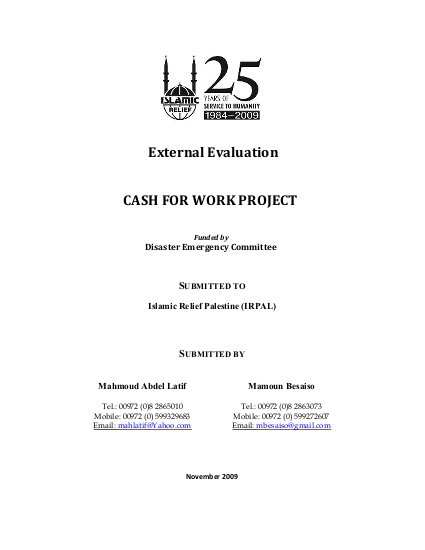
This report presents the findings of the final external evaluation for the Cash for Work project funded by the Disasters Emergency Committee and implemented by Islamic Relief. The evaluation work was carried out by external consultants over a one month period starting October 20, 2009. This project was initiated, designed, and implemented with the goal of improving the living conditions of the target breadwinners in Gaza strip and delivery of the following outputs: • Providing 219 unemployed labour forces with temporary job opportunities for a 2 month period • Alleviating the hardship conditions of about 1533 people and to access the beneficiaries from the basic need • Enabling the municipalities to carry out the repair and maintenance of some facilities This project is a response to the Gaza crisis. The social and economic infrastructure of Gaza sustained extensive physical damage. According to the Palestinian Authority, 4,036 housing units were destroyed and a further 11,514 were partially damaged, leaving tens of thousands of displaced persons. Government buildings, water, energy and communications infrastructure, educational establishments and hospitals all sustained significant damage. The employment situation in Gaza went from bad to worse under the impact of the total blockade which has virtually strangled all regular economic activity. This was reflected in a steep increase in unemployment in Gaza, from 28.9 per cent to 44.8 per cent (16 percentage points). These numbers are likely to have increased even more following the military invasion of Gaza in January 2009. The employment rate (population aged 15 and over) declined further in Gaza to 21.4 per cent – equivalent to one person in five in that age group. Both rates are extremely low by international standards. Another measure of the scarcity of employment is the dependency ratio: on average, one employed person supports 8.8 persons in Gaza. The aim of this evaluation is to assess the effectiveness of the project in achieving the stated goal and objectives and to examine the extent to which the projects' inputs have been converted into outputs and results. In addition to extracting lessons learnt which can be taken into consideration in design of future similar projects. The evaluation process used mixed methods including interviewing individuals, holding focus group discussions, conducting surveys and site visits to partner organizations and project sites.
